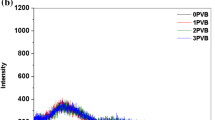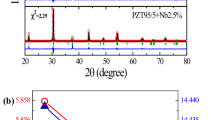Abstract
The temperature dependence of dc electrical conductivity was measured by two-probe technique in the vicinity of phase transition point for ferroelectrics sodium vanadate and rubidium vanadate doped with different concentrations of La2O3. These materials show a sharp change in conductivity at their phase transition temperatures. The results were found to obey the conventional exponential law and the activation energies were calculated for ferroelectric and paraelectric states. It was found that activation energy in ferroelectric phase is smaller than in the paraelectric phase. The activation energy increases slowly with increase in doping concentration of La2O3 up to 0·1 mol%, however, it decreases with further increase in doping concentration, in both ferro and para states. The dc electrical conductivity below the Curie temperature is of mixed type (ionic-electronic) while it is electronic type above the Curie temperature.
Similar content being viewed by others
References
Chavan S H and Kulkarni A J 1993J. Phys. Status Solidi a35 307
Feigelson R, Martin G and Johnson B J 1972Crystal Growth (Germany) 13/14 686
Gaur K and Lal H B 1985J. Mater. Sci. (Poland) 20 3167
Gaur K and Lal H B 1986J. Mater. Sci. (USA) 21 2289
Gopala Krishnan R and Seshamma S 1991Bull. Mater. Sci. 14 1349
Grawford A E 1959Br. Commun. Electronics 6 516
Guruvich V M and Rez I S 1960Sov. Phys. Solid State 2 624
Hawthorne F and Calvo C 1977J. Solid State Chem. 22 157
Patil V V, Kashid A P and Chavan S H 1989Bull. Mater. Sci. 12 133
Patil N B, Patil R T and Chavan S H 1990Indian J. Pure Appl. Phys. 28 276
Rasal S P, Magdum T S, Pawar D V and Chavan S H 1993Ferroelectrics 139 57
Sawyer C B and Tower C H 1930Phys. Rev. 35 269
Sakai T, Adachi G, Shiokawa J and Shinike T 1976Mater. Res. Bull. 11 1295
Tawfik A, Sekina M M A and El-Nimr M K 1978Indian J. Phys. A52 164
Verma B and Lal H 1981Mater. Res. Bull. 16 1679
Weston T B, Webster A H and McNamara N H 1969J. Am. Ceram. Soc. 52 253
Author information
Authors and Affiliations
Rights and permissions
About this article
Cite this article
Pawar, D.V., Magdum, T.S. & Chavan, S.H. Lanthanum oxide doping effect on dc electrical conductivity of ferroelectrics sodium vanadate and rubidium vanadate. Bull. Mater. Sci. 18, 141–146 (1995). https://doi.org/10.1007/BF02747533
Received:
Revised:
Issue Date:
DOI: https://doi.org/10.1007/BF02747533




